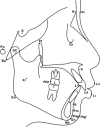Morphological characteristics influencing the orthodontic extraction strategies for Angle's class II division 1 malocclusions
- PMID: 25033988
- PMCID: PMC4884047
- DOI: 10.1186/s40510-014-0044-y
Morphological characteristics influencing the orthodontic extraction strategies for Angle's class II division 1 malocclusions
Abstract
Background: Extraction has now been accepted widely in various malocclusions including Angle's class II division 1. However, the levels of scientific evidence in orthodontic treatment planning have been weak, and it is unlikely to systematically provide a rationale and consistent basis in decisions of extraction. This study was retrospectively designed to investigate the initial morphologic characteristics of class II division 1 subjects involving four different extraction strategies, to determine the relevant influential factors when choosing extraction strategies with the most commonly used mechanics and the principle of simplicity in orthodontic treatment based on cases diagnosed and treated by an experienced orthodontist.
Methods: One hundred and ten samples of Angle's class II division 1 malocclusion with good facial and occlusal outcomes after orthodontic treatment were selected and divided into four groups according to different extraction patterns. For each case, pretreatment models and the lateral radiographs were analyzed. Significant variables of models and craniofacial structures of each group were identified by comparing the measurements using one-way analysis of variance (ANOVA) at a significance level of P < 0.05. Then, binary logistic regression analysis was used and a regression equation was established to quantify the correlations among the significant variables and their contributions to the extraction decisions.
Results: Molar relationship, lower anterior crowding, anterior Bolton index, and anterior overjet measured from models, as well as ANS-Xi-Pm, NBa-PtGn, Li-NsPog', U1-NPog and L1-NPog measured from lateral radiographs were found to be statistically significant. Binary logistic regression analysis revealed that lower anterior crowding, molar relationship, and growth pattern were the three most relevant influential factors with a declining impact contributing to the extraction decisions for Angle's class II division 1 malocclusions.
Conclusions: Angle's class II division 1 malocclusions exhibit various morphological characteristics. Orthodontists should comprehensively consider the reciprocal impact of multiple factors when choosing different extraction strategies for Angle's class II division 1 malocclusions.
Figures

References
-
- Hahn GW. Orthodontics; its objectives, past and present. Am J Orthod Oral Surg. 1944;42:17–21. - PubMed
-
- Tweed CH. Indications for the extraction of teeth in orthodontic procedure. Am J Orthod Oral Surg. 1944;42:22–45. - PubMed
-
- Case CS. The question of extraction in orthodontia. Am J Orthod. 1964;50:660–91. doi: 10.1016/0002-9416(64)90106-X. - DOI
Publication types
MeSH terms
LinkOut - more resources
Full Text Sources
Other Literature Sources

